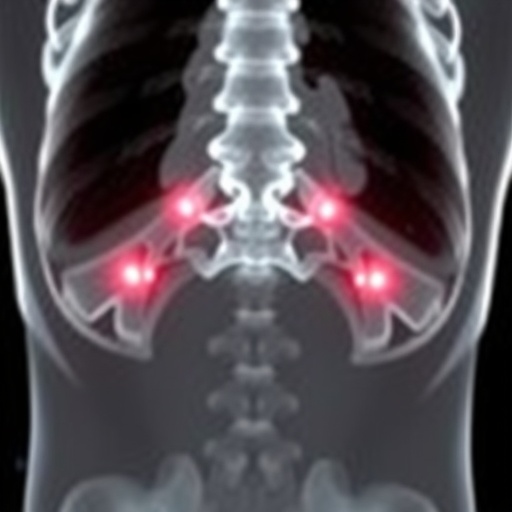In the relentless pursuit of better outcomes for patients diagnosed with advanced osteosarcoma, a groundbreaking clinical investigation has emerged, potentially shifting the therapeutic landscape. The study, recently published in Nature Communications, explores the efficacy of combining Apatinib—a targeted anti-angiogenic agent—with the conventional chemotherapy regimen of ifosfamide and etoposide. This randomized phase II trial, OAIE/PKUPH-sarcoma 11, represents a critical examination of whether adding Apatinib can enhance clinical responses in this notoriously difficult-to-treat malignancy.
Osteosarcoma, a primary malignant bone tumor predominantly affecting adolescents and young adults, has remained a formidable clinical challenge. Despite aggressive multi-agent chemotherapy and surgical interventions, survival rates for advanced-stage patients have plateaued, largely due to intrinsic tumor resistance and metastatic progression. The integration of targeted therapies into standard chemotherapy regimens has been an area of avid research interest, aiming to disrupt tumor angiogenesis and improve chemosensitivity.
Apatinib, a potent inhibitor of vascular endothelial growth factor receptor-2 (VEGFR-2), works by curtailing the neovascularization that tumors depend on for growth and metastasis. Given its anti-angiogenic mechanism, Apatinib holds promise for tumors with high angiogenic activity, such as osteosarcoma. In this trial, the researchers hypothesized that pairing Apatinib with ifosfamide and etoposide, agents that interfere with DNA synthesis and repair, could exert synergistic effects by attacking the cancer through complementary pathways.
The randomized, open-label study enrolled patients with advanced osteosarcoma, randomly assigning them to receive either the combination of Apatinib plus ifosfamide and etoposide or the traditional chemotherapy regimen alone. Primary endpoints focused on progression-free survival (PFS), while secondary measures included overall survival (OS), objective response rate (ORR), and safety profiles. The trial’s design emphasized meticulous monitoring of adverse events alongside therapeutic efficacy to balance benefit-risk considerations.
Results from the OAIE/PKUPH-sarcoma 11 study revealed a statistically significant improvement in progression-free survival among patients receiving the combination therapy. This finding marks an encouraging milestone, as extending the period during which the disease remains controlled can profoundly impact patient quality of life and long-term outcomes. Moreover, the combination group exhibited higher objective response rates, indicating a more substantial proportion of patients experienced meaningful tumor shrinkage.
In addition to efficacy, the safety profile of Apatinib plus chemotherapy was carefully evaluated. While the combination was associated with higher incidences of certain adverse events—such as hypertension, proteinuria, and hand-foot syndrome—these toxicities were, in general, manageable with appropriate supportive care measures. Importantly, no unexpected safety signals emerged, underscoring the regimen’s feasibility in the advanced osteosarcoma patient population.
Mechanistically, the study’s findings resonate with preclinical data supporting the blockade of VEGFR-2 as a potent anti-angiogenic strategy. Apatinib’s ability to starve tumors of their vascular supply appears to sensitize cancer cells to the cytotoxic assaults of ifosfamide and etoposide. This dual assault may not only inhibit tumor growth but also limit metastatic dissemination, addressing two critical hurdles in advanced disease management.
The integration of molecularly targeted agents like Apatinib into chemotherapy protocols also represents a step toward more personalized oncology care. Recognizing tumor heterogeneity and the complex interplay of oncogenic pathways prompts an evolving paradigm where combinations can be tailored based on molecular vulnerabilities. Future studies might refine patient selection criteria, potentially incorporating biomarkers predictive of response to VEGFR-2 inhibition.
Another compelling aspect of this study is its potential to influence clinical guidelines and standard-of-care recommendations. While previous treatments for advanced osteosarcoma have stagnated, these new findings may prompt oncologists to adopt Apatinib-based regimens, provided these results are validated in larger phase III trials. The promise of improved survival outcomes accompanied by manageable toxicity profiles could redefine therapeutic algorithms.
Beyond immediate clinical applications, the OAIE/PKUPH-sarcoma 11 trial underscores the vital role of well-designed randomized studies in rare cancers. Osteosarcoma’s relative rarity often limits large-scale trials; yet, this study demonstrates how rigorous phase II data can inform both clinical practice and future research directions. Multidisciplinary collaboration between oncologists, pharmacologists, and molecular biologists was instrumental in translating laboratory insights into tangible patient benefits.
Moreover, the study invites exploration of combining anti-angiogenic agents with other novel therapeutic modalities, such as immunotherapies. Given the immune-suppressive microenvironment that angiogenesis fosters, normalizing tumor vasculature through VEGFR-2 inhibition might improve immune cell infiltration and efficacy of checkpoint inhibitors. Synergistic regimens could offer unprecedented control over advanced osteosarcoma.
In terms of the broader oncology field, this research contributes to the expanding knowledge on how targeting the tumor microenvironment can complement direct cytotoxic approaches. Angiogenesis inhibitors have transformed treatment paradigms in several solid tumors. This trial provides fresh evidence supporting their role in sarcoma—a historically challenging tumor type—thus broadening the scope of anti-angiogenic therapy.
Importantly, patient-centric outcomes remain critical. Incorporating quality of life assessments and long-term survivorship plans will be necessary to fully understand the real-world impact of adding Apatinib to chemotherapy. While extending progression-free intervals is invaluable, maintaining daily functioning and minimizing debilitating side effects are equally paramount considerations.
Looking ahead, validation of these phase II results in larger, multinational cohorts is essential. Phase III studies will help confirm durability of response, clarify optimal dosing strategies, and evaluate cost-effectiveness of the Apatinib combination. Additionally, genomic and proteomic analyses could unravel resistance mechanisms, guiding subsequent therapeutic adjustments.
This study also exemplifies the promise of international collaborative networks. Pooling expertise and patient populations from multiple centers accelerates clinical discovery and enhances statistical power. Such cooperation is vital for rare diseases like osteosarcoma, where single institutions often lack sufficient caseloads for definitive trials.
In conclusion, the OAIE/PKUPH-sarcoma 11 trial presents compelling evidence for the efficacy and safety of combining Apatinib with ifosfamide and etoposide in patients with advanced osteosarcoma. This innovative approach not only advances therapeutic options for a vulnerable patient population but also reinvigorates hope for improved survival and disease control. As ongoing research builds upon these findings, the future of osteosarcoma treatment looks poised for transformative change.
Subject of Research: Advanced osteosarcoma treatment efficacy using Apatinib combined with ifosfamide and etoposide versus standard chemotherapy.
Article Title: Apatinib plus ifosfamide and etoposide versus ifosfamide and etoposide in patients with advanced osteosarcomas (OAIE/PKUPH-sarcoma 11): a randomized phase II study.
Article References:
Xie, L., Xu, J., Sun, X. et al. Apatinib plus ifosfamide and etoposide versus ifosfamide and etoposide in patients with advanced osteosarcomas (OAIE/PKUPH-sarcoma 11): a randomized phase II study. Nat Commun 16, 10473 (2025). https://doi.org/10.1038/s41467-025-65467-8
Image Credits: AI Generated
DOI: https://doi.org/10.1038/s41467-025-65467-8
Tags: Apatinib in osteosarcoma treatmentchallenges in osteosarcoma treatmentchemotherapy for advanced osteosarcomacombining Apatinib with ifosfamideefficacy of Apatinib in malignancyimproving survival rates in osteosarcomainnovative treatments for adolescent bone tumorsneovascularization and tumor growthphase II clinical trial osteosarcomapotential of targeted therapies in chemotherapytargeted anti-angiogenic therapyVEGFR-2 inhibition in cancer





